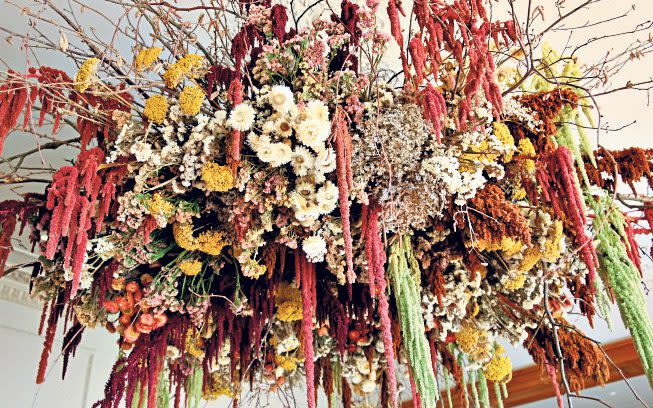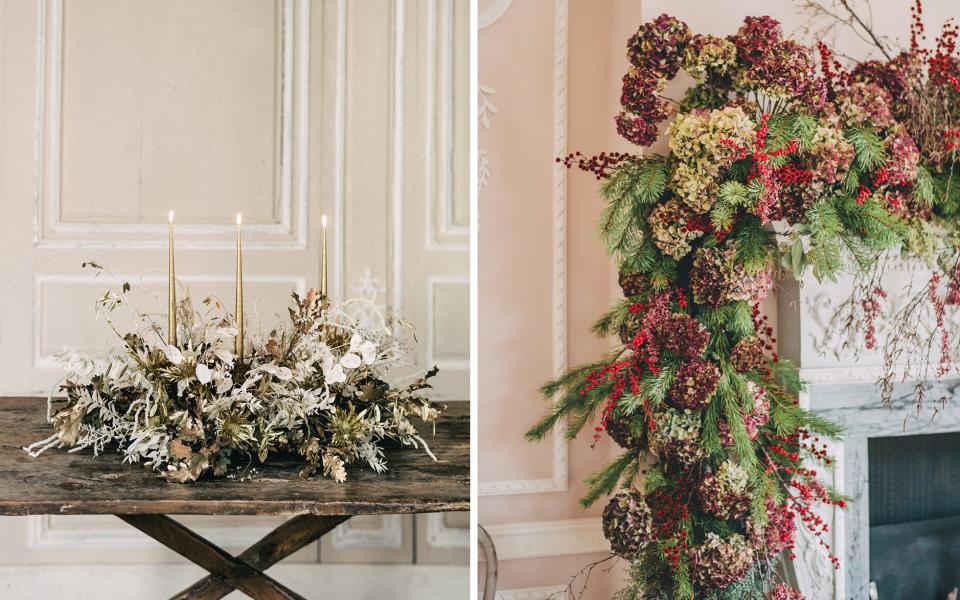How everlasting blooms threw struggling florists a lifeline over lockdown

Back in March, just as the first lockdown was ushered in, Fiona Haser-Bizony, owner of the Electric Daisy Flower Farm in Somerset, found herself in a similar predicament to scores of growers and floral designers across the country. The wedding and events industry came to an abrupt standstill with almost every booking cancelled.
The flowers, of course, kept on growing. But Fiona was in a more precarious situation than most – just one month previously she had launched a London shop in Hampstead, which was abruptly closed just weeks after it had opened.
Like many others she found a lifeline in drying her crops. “With all the vagaries of Covid-19 it feels like the dry flower stock we have in our barns is our winter gold. We feel like virtuous ants who have stored their harvest while the grasshopper made music all summer,” says Fiona, who added walls, windows and a wood-burning stove to her barn to ensure the flowers on her giant drying racks stayed in pristine condition.
“We are going into our least flowery period and having opened a retail shop in London, having no flowers is not an option.”
On the Suffolk coast, at the Southwold Flower Co, it has been a similar story, where flower farmer Liz Mobbs lost all but three of her summer wedding bookings. While she did a roaring trade in “pick your own” fresh flowers, serendipitously she had already decided to turn over about an eighth of her field to growing annuals, perennials, grasses and foliage for drying with colleague Sharon Hadden.
“It was really a complete punt,” says Sharon. “But we couldn’t have picked a better year to start.” Their dried bunches sell to wholesalers, retailers – such as the nearby arts complex Snape Maltings, which swiftly sold out of its first delivery – as well as from their own flower-filled barn. They’ve also hosted sell-out workshops where visitors can hand-craft their own dried wreaths and everlasting floral domes. “We live in this technological world which is crazy and instant but we need something to pull us back,” adds Sharon. “Everyone is looking for that.”

But even before dried flowers threw a lifeline to British growers, they had already been enjoying a huge resurgence, fuelled by millennials for whom arrangements of voguish plumes of pampas, miscanthus and pennisetum in stoneware pots or sculptural planters have threatened the dominance of the fiddle leaf fig as the decade’s most ubiquitous decorative detail.
If everlasting flowers (which you are now as likely to find in The Conran Shop or Liberty as the farmers’ market) once provided a cold season alternative to fresh (which of course they still do) there’s now more at play. For a new generation they are a cheaper and more sustainable alternative, too.
“They often last months if not years and this is appealing, particularly to more conscious younger generations,” agrees Bex Partridge, author of this year’s Everlastings: How to Grow, Harvest and Create with Dried Flowers (£14.99, Hardie Grant). “Then there is the sustainability side to them; there is a wider movement towards more local, native and ‘organic’ flowers and dried flowers are following this movement.”
Her Instagram feed (@botanical_tales) showcases soulful shots of flower-filled interiors that are lapped up by her 64,000 followers. “Dried flowers also bring extra movement and texture to a room and they are a way to invite nature in, particularly as we move to the darker months of winter,” adds Bex. “The more structural seed heads and grasses offer something for those who are looking for a contemporary look.”
Social media has, of course, turbocharged the popularity of everlastings, with images of interiors beautified by bunches, hoops and arrangements of drying stems. Just Dahlias’ Philippa Stewart, who, like many British growers, is part of the Flowers from the Farm co-operative, has turned her entire house into a living work of art by suspending blankets of drying pom-poms and dinnerplate dahlias from every ceiling in her house. She regularly posts the results on her Instagram, @justdahlias.
At Phohm, a dried flower emporium which opened this summer in Brighton, founder Phoebe Mulrooney, who trained in fine art at Camberwell before working as a stylist and prop maker, creates everlasting arrangements and installations for homes but also for businesses for whom a highly Instagrammable installation can often equal a significant amount of free marketing.
But the popularity of dried flowers is more than just a social media moment. The palettes are also key – faded colours or earthy neutrals chime with the return to natural materials and organic forms in our homes. For floral designer and flower farmer Juliet Glaves, the shift towards these “parchment colours” is another way that the new wave of dried is quite distinct from what came before.
She regularly works with nettle stems, wild clematis and her favourite bulrushes. “Nobody seems to use them but I adore working with them. As a seasonal florist you have to find and create beauty at all times of the year.”

While wild bunches, garlands and wreaths have certainly been central to the revival in fortunes of everlasting flowers, it’s also been fuelled by a band of floral designers and their often awe-inspiring installations of gypsophila, smoke bush or hydrangeas that float in rooms like seemingly weightless clouds.
Few have done more to popularise these installations than Ruby Barber of the Berlin-based studio Mary Lennox, whose creations for brands such as Hermes, Chanel and Gucci sit somewhere between floristry and fine art.
Her botanical clouds kick-started a global trend for airy, ethereal installations in bars, stores and restaurants such as Mercato Mayfair, where Deborah Bain’s clouds of lunaria float through the vertiginous neoclassical interior of the Grade I listed former church.
At Heckfield Place hotel, Kitten Grayson’s ethereal hanging sculptures of grasses and flowers are left to dry in situ. Such is the popularity of these floral works of art that she has now launched a new service, Everlasting Installations, extending the stunning floral installations to other commercial spaces or private homes.
Each commission begins with a consultation to consider the setting, colour palette and choice of material and Grayson and her team will also return to update and maintain with new stems where necessary.
Few installations can compete with the floral garland that is created every Christmas at the National Trust Tudor property, Cotehele in Cornwall, where work begins in early November to create a base for a 60ft garland, which is decorated entirely with flowers grown on the estate – a tradition that dates back to 1956 and continues, Covid allowing, this year.
But the beauty of dried is that it works on any scale. And if further inspiration is needed, turn to artist Rebecca Louise Law, who was one of the first practitioners to take flowers and turn them into living art, with her awe-inspiring site-specific installations that include enormous cases of meticulously arranged flowers or ceilings entirely covered with a sea of blooms that appear in institutions such as the Garden Museum in London as well as in galleries across the globe.
This year she is exhibiting Florilegium in the exquisite interiors of Parma’s Oratorio di San Tiburzio until Dec 19 where 200,000 drying blooms are suspended in the vaulted ceilings and in trails throughout the space.
It’s a poetic sight – and it’s the perfect illustration of how the simplest blooms, drying naturally, can create something truly other-worldly.
Classes to look out for
Rachel Wardley of Tallulah Rose Flower School has launched online everlastings workshops, including a class on creating a flower cloud (£50, tallulahroseflowers.com).
Botanical stylist Carolyn Dunster, who next spring will publish Cut & Dry – a manual for growing, harvesting and drying flowers for use at home - will host workshops in creating a suspended botanical cloud next April (£160, minervaworkshop.co.uk).
Pesh Flowers offer a virtual class via Zoom on making a Dried Flower Hoop on January 21, 7pm – 8:45pm, £60 (peshflowers.co.uk).
Bex Partridge is not currently able to run in-person workshops. However, she offers an online seasonal wreath tutorial year round and group and one-to-one workshops on a range of creative projects. Contact her at botanicaltales.com.

